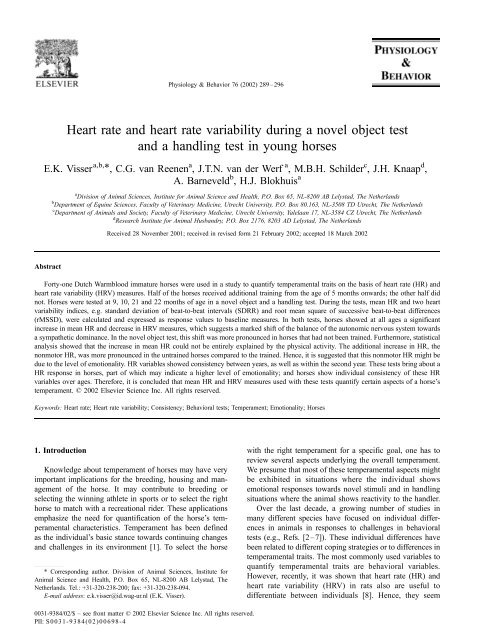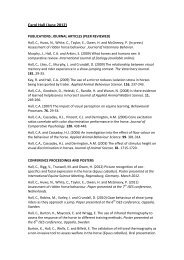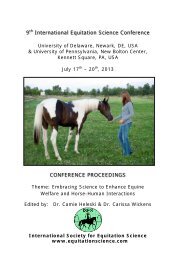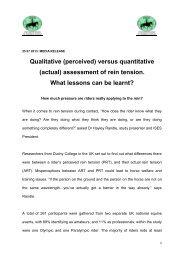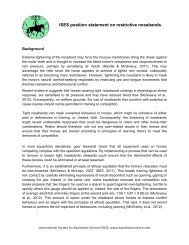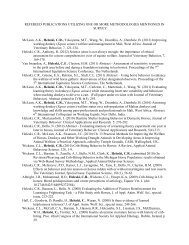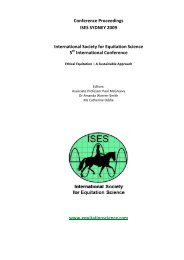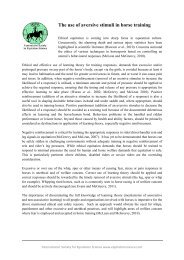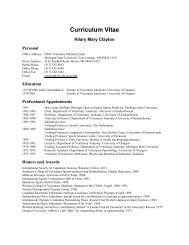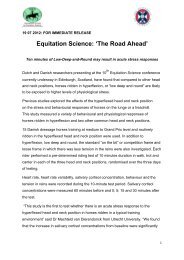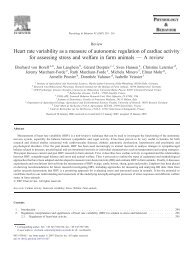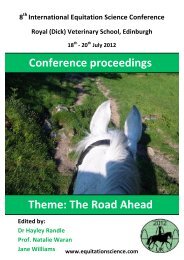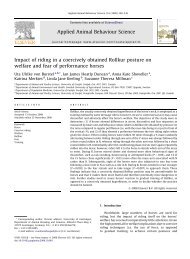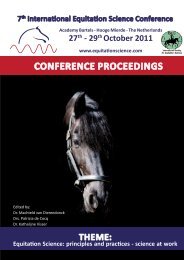Heart rate and heart rate variability during a novel object test and a ...
Heart rate and heart rate variability during a novel object test and a ...
Heart rate and heart rate variability during a novel object test and a ...
You also want an ePaper? Increase the reach of your titles
YUMPU automatically turns print PDFs into web optimized ePapers that Google loves.
Physiology & Behavior 76 (2002) 289–296<br />
<strong>Heart</strong> <strong>rate</strong> <strong>and</strong> <strong>heart</strong> <strong>rate</strong> <strong>variability</strong> <strong>during</strong> a <strong>novel</strong> <strong>object</strong> <strong>test</strong><br />
<strong>and</strong> a h<strong>and</strong>ling <strong>test</strong> in young horses<br />
E.K. Visser a,b, *, C.G. van Reenen a , J.T.N. van der Werf a , M.B.H. Schilder c , J.H. Knaap d ,<br />
A. Barneveld b , H.J. Blokhuis a<br />
a Division of Animal Sciences, Institute for Animal Science <strong>and</strong> Health, P.O. Box 65, NL-8200 AB Lelystad, The Netherl<strong>and</strong>s<br />
b Department of Equine Sciences, Faculty of Veterinary Medicine, Utrecht University, P.O. Box 80.163, NL-3508 TD Utrecht, The Netherl<strong>and</strong>s<br />
c Department of Animals <strong>and</strong> Society, Faculty of Veterinary Medicine, Utrecht University, Yalelaan 17, NL-3584 CZ Utrecht, The Netherl<strong>and</strong>s<br />
d Research Institute for Animal Husb<strong>and</strong>ry, P.O. Box 2176, 8203 AD Lelystad, The Netherl<strong>and</strong>s<br />
Received 28 November 2001; received in revised form 21 February 2002; accepted 18 March 2002<br />
Abstract<br />
Forty-one Dutch Warmblood immature horses were used in a study to quantify temperamental traits on the basis of <strong>heart</strong> <strong>rate</strong> (HR) <strong>and</strong><br />
<strong>heart</strong> <strong>rate</strong> <strong>variability</strong> (HRV) measures. Half of the horses received additional training from the age of 5 months onwards; the other half did<br />
not. Horses were <strong>test</strong>ed at 9, 10, 21 <strong>and</strong> 22 months of age in a <strong>novel</strong> <strong>object</strong> <strong>and</strong> a h<strong>and</strong>ling <strong>test</strong>. During the <strong>test</strong>s, mean HR <strong>and</strong> two <strong>heart</strong><br />
<strong>variability</strong> indices, e.g. st<strong>and</strong>ard deviation of beat-to-beat intervals (SDRR) <strong>and</strong> root mean square of successive beat-to-beat differences<br />
(rMSSD), were calculated <strong>and</strong> expressed as response values to baseline measures. In both <strong>test</strong>s, horses showed at all ages a significant<br />
increase in mean HR <strong>and</strong> decrease in HRV measures, which suggests a marked shift of the balance of the autonomic nervous system towards<br />
a sympathetic dominance. In the <strong>novel</strong> <strong>object</strong> <strong>test</strong>, this shift was more pronounced in horses that had not been trained. Furthermore, statistical<br />
analysis showed that the increase in mean HR could not be entirely explained by the physical activity. The additional increase in HR, the<br />
nonmotor HR, was more pronounced in the untrained horses compared to the trained. Hence, it is suggested that this nonmotor HR might be<br />
due to the level of emotionality. HR variables showed consistency between years, as well as within the second year. These <strong>test</strong>s bring about a<br />
HR response in horses, part of which may indicate a higher level of emotionality; <strong>and</strong> horses show individual consistency of these HR<br />
variables over ages. Therefore, it is concluded that mean HR <strong>and</strong> HRV measures used with these <strong>test</strong>s quantify certain aspects of a horse’s<br />
temperament. D 2002 Elsevier Science Inc. All rights reserved.<br />
Keywords: <strong>Heart</strong> <strong>rate</strong>; <strong>Heart</strong> <strong>rate</strong> <strong>variability</strong>; Consistency; Behavioral <strong>test</strong>s; Temperament; Emotionality; Horses<br />
1. Introduction<br />
Knowledge about temperament of horses may have very<br />
important implications for the breeding, housing <strong>and</strong> management<br />
of the horse. It may contribute to breeding or<br />
selecting the winning athlete in sports or to select the right<br />
horse to match with a recreational rider. These applications<br />
emphasize the need for quantification of the horse’s temperamental<br />
characteristics. Temperament has been defined<br />
as the individual’s basic stance towards continuing changes<br />
<strong>and</strong> challenges in its environment [1]. To select the horse<br />
* Corresponding author. Division of Animal Sciences, Institute for<br />
Animal Science <strong>and</strong> Health, P.O. Box 65, NL-8200 AB Lelystad, The<br />
Netherl<strong>and</strong>s. Tel.: +31-320-238-200; fax: +31-320-238-094.<br />
E-mail address: e.k.visser@id.wag-ur.nl (E.K. Visser).<br />
with the right temperament for a specific goal, one has to<br />
review several aspects underlying the overall temperament.<br />
We presume that most of these temperamental aspects might<br />
be exhibited in situations where the individual shows<br />
emotional responses towards <strong>novel</strong> stimuli <strong>and</strong> in h<strong>and</strong>ling<br />
situations where the animal shows reactivity to the h<strong>and</strong>ler.<br />
Over the last decade, a growing number of studies in<br />
many different species have focused on individual differences<br />
in animals in responses to challenges in behavioral<br />
<strong>test</strong>s (e.g., Refs. [2–7]). These individual differences have<br />
been related to different coping st<strong>rate</strong>gies or to differences in<br />
temperamental traits. The most commonly used variables to<br />
quantify temperamental traits are behavioral variables.<br />
However, recently, it was shown that <strong>heart</strong> <strong>rate</strong> (HR) <strong>and</strong><br />
<strong>heart</strong> <strong>rate</strong> <strong>variability</strong> (HRV) in rats also are useful to<br />
differentiate between individuals [8]. Hence, they seem<br />
0031-9384/02/$ – see front matter D 2002 Elsevier Science Inc. All rights reserved.<br />
PII: S0031-9384(02)00698-4
290<br />
E.K. Visser et al. / Physiology & Behavior 76 (2002) 289–296<br />
relevant additional variables to quantify individual differences<br />
in temperamental aspects.<br />
HR represents the net effect of the parasympathetic nerves<br />
that slow it down <strong>and</strong> the sympathetic nerves that accele<strong>rate</strong><br />
it. In resting conditions, both parts of the autonomic nervous<br />
system are thought to be tonically active. Different stressors<br />
can induce a shift of the autonomic balance towards either a<br />
sympathetic or a parasympathetic dominance [9–12]. A<br />
decreased HRV reflects a shift of the autonomic balance<br />
towards a more sympathetic dominance [8,13,14]. Several<br />
studies on rodents have shown that stressful conditions,<br />
depending on their nature, can result in a decrease in HRV<br />
<strong>and</strong> hence low levels of parasympathetic nerve activity [8].<br />
For example, social defeat in rats produces lower HRV<br />
measures compared to baseline recordings, whereas other<br />
stressors including restraint, swimming <strong>and</strong> shock-probe <strong>test</strong><br />
do not [15]. In a human study by Friedman <strong>and</strong> Thayer [16],<br />
it was shown that patients with chronic anxiety (panic<br />
disorder) exhibit lower levels of HRV <strong>and</strong> higher levels of<br />
mean HR compared to their controls. The parasympathetic<br />
branch of the autonomic nervous system seems to be<br />
associated with adaptive responsivity to the environment<br />
[17]. Individuals with a higher parasympathetic activity<br />
would be more exploratory <strong>and</strong> adaptive to environmental<br />
dem<strong>and</strong>s. In another study, Porges [18] showed that parasympathetic<br />
activity is suppressed <strong>during</strong> autonomic <strong>and</strong><br />
behavioral responses to stress. Thus, responses of the autonomic<br />
nervous system on challenging situations differentiate<br />
between individuals. These differences could therefore<br />
reflect differences in temperament. It was shown that horses,<br />
when confronted with a challenging situation, exhibited<br />
individually different behavioral responses, <strong>and</strong> this was<br />
suggested to be linked with differences in temperament [7].<br />
We hypothesize that responses of the autonomic nervous<br />
system may also be useful in differentiating between individual<br />
horses in terms of temperament.<br />
In the present study, we aimed to investigate whether<br />
responses of HR <strong>and</strong> HRV to challenging situations could<br />
differentiate between individual horses’ temperament. It is<br />
hypothesized that a confrontation with a <strong>novel</strong> <strong>object</strong> causes<br />
an emotional state, possibly ‘fear’, which is reflected in an<br />
additional increase in mean HR <strong>and</strong> a decrease in HRV.<br />
Since HR (<strong>and</strong> HRV) is also affected by physical activity<br />
[8], physical activity was explicitly considered in the statistical<br />
analysis in an attempt to distinguish between variation<br />
in HR due to physical activity <strong>and</strong> variation in<br />
nonmotor HR [19]. A second <strong>test</strong> involving human h<strong>and</strong>ling<br />
was used to investigate whether individual horses responded<br />
differently to situations of challenge with or without the<br />
support of a human.<br />
2. Materials <strong>and</strong> methods<br />
All procedures involving animal h<strong>and</strong>ling <strong>and</strong> <strong>test</strong>ing<br />
were approved by the Animal Care <strong>and</strong> Use Committee of<br />
the Institute for Animal Science <strong>and</strong> Health (ID-Lelystad) in<br />
Lelystad, the Netherl<strong>and</strong>s.<br />
2.1. Animals, housing, h<strong>and</strong>ling <strong>and</strong> management<br />
A total of 41 Dutch warmblood horses, 26 colts <strong>and</strong> 15<br />
fillies were used in this study. Experiments were carried out<br />
at the Research Station for Animal Husb<strong>and</strong>ry in Lelystad.<br />
Horses were simultaneously used in a project aiming at the<br />
development of scientific criteria for the selection <strong>and</strong><br />
effective <strong>and</strong> injury-free training of show jumpers. To<br />
evaluate the effects of training at a young age, half of the<br />
horses were trained from the age of 6 months, <strong>and</strong> the other<br />
half were not. Horses were blocked by pedigree, date of<br />
birth, sex <strong>and</strong> free-jumping performance at 5 months of age,<br />
<strong>and</strong> they were r<strong>and</strong>omly allocated to one of the two<br />
treatment groups: training (n = 21: 13 colts, 8 fillies) <strong>and</strong><br />
nontraining (n = 20: 13 colts <strong>and</strong> 7 fillies). Horses were held<br />
in groups in half-open, straw-bedded stables in winter <strong>and</strong><br />
on pasture in summer. At stable, horses were fed concent<strong>rate</strong>s<br />
in the morning <strong>and</strong> in the afternoon. Before noon,<br />
horses received additional straw <strong>and</strong> grass silage. Water was<br />
available ad libitum. (For more details, see Ref. [7].) Due to<br />
health problems, three horses were excluded from this study<br />
before the start of the second winter period.<br />
2.2. Testing procedures<br />
During two winter periods, a <strong>novel</strong> <strong>object</strong> <strong>test</strong> <strong>and</strong> a<br />
h<strong>and</strong>ling <strong>test</strong> were conducted. Both <strong>test</strong>s were carried out<br />
four times, i.e. when the horses were approximately 9, 10,<br />
21 <strong>and</strong> 22 months old. The experimental design used in this<br />
study is described in detail by Visser et al. [7].<br />
Briefly, the <strong>novel</strong> <strong>object</strong> <strong>test</strong> was carried out in an indoor<br />
arena of 18 21 m. After a 2-min waiting period in a socalled<br />
starting box, the horse was released into the arena. Two<br />
minutes after the horse entered the arena, the <strong>novel</strong> <strong>object</strong> (an<br />
open blue <strong>and</strong> white umbrella) was lowered from the ceiling,<br />
from approximately 6 m height. The umbrella stood straight<br />
up for another 5 min allowing the horse to investigate it.<br />
Then, the horse was caught by the h<strong>and</strong>lers <strong>and</strong> led back to its<br />
stable. The h<strong>and</strong>ling <strong>test</strong> comprised of a familiar h<strong>and</strong>ler<br />
leading the horse to a so-called ‘bridge’. This bridge consisted<br />
of four concrete plates (four plates of 2 1 m), creating<br />
a bridge 2 m wide <strong>and</strong> 4 m long. The top level of which was<br />
elevated 15 cm above the ground. While approaching the<br />
bridge, the h<strong>and</strong>ler did not pull, touch or talk to the horse. If<br />
the horse stopped walking, the h<strong>and</strong>ler walked on until the<br />
rope was slightly tensioned. If the horse continued the<br />
approach, the h<strong>and</strong>ler moved on. Tough resistance, like<br />
pulling backwards, rearing or walking along the sides, was<br />
followed by another trial. Each horse had a maximum of three<br />
trials per <strong>test</strong> to cross the bridge. The starting point of every<br />
trial was approximately 12 m in front of the bridge, the horse<br />
facing the bridge. After the horse had crossed the bridge<br />
or reached the maximum number of trials, it was led back to
E.K. Visser et al. / Physiology & Behavior 76 (2002) 289–296 291<br />
Table 1<br />
HR <strong>and</strong> HRV indices (means ± S.E.M.) for the baseline values <strong>and</strong> the<br />
corresponding <strong>novel</strong> <strong>object</strong> <strong>test</strong> values at 9, 10, 21 <strong>and</strong> 22 months of age<br />
(n = 41, 41, 38 <strong>and</strong> 38, respectively)<br />
9 Months 10 Months 21 Months 22 Months<br />
HR (bpm)<br />
Baseline 53.7 ± 1.4 a 54.0 ± 2.1 a 47.3 ± 1.1 a 47.6 ± 1.1 a<br />
Test 159.5 ± 4.4 b 142.6 ± 4.6 b 129.4 ± 5.6 b 113.9 ± 5.4 b<br />
SDRR (ms)<br />
Baseline 131.1 ± 9.5 a 133.8 ± 7.0 a 286.9 ± 23.0 a 208.8 ± 15.5 a<br />
Test 91.4 ± 7.0 b 106.6 ± 7.1 b 131.2 ± 12.0 b 132.3 ± 9.1 b<br />
rMSSD (ms)<br />
Baseline 46.3 ± 4.8 a 42.0 ± 2.8 a 61.3 ± 4.7 a 56.1 ± 6.1 a<br />
Test 15.8 ± 1.9 b 18.6 ± 1.7 b 22.8 ± 2.9 b 28.2 ± 2.8 b<br />
a,b Means of baseline <strong>and</strong> corresponding <strong>test</strong> value with different letter per<br />
HR variable per age differ significantly ( P < .05).<br />
the stable by a h<strong>and</strong>ler. This latter procedure was executed at<br />
9 <strong>and</strong> 10 months of age. During the second year<br />
(21 <strong>and</strong> 22 months of age), the following adjustment was<br />
made to ensure enough variation between individuals.<br />
Yellow wooden plates were attached on top of the concrete<br />
plates to avoid habituation. Three horses had to be excluded<br />
from this <strong>test</strong> at the age of 22 months due to dangerous<br />
behavior towards the experimenters <strong>during</strong> <strong>test</strong>ing.<br />
2.3. Data acquisition <strong>and</strong> processing<br />
HR was recorded with Polar Vantage (Polar Electro OY,<br />
Kemple, Finl<strong>and</strong>), which consisted of an electrode belt with<br />
built-in transmitter <strong>and</strong> a wristwatch receiver. Warm water<br />
<strong>and</strong> methylated spirit were used to optimize the contact<br />
between electrode <strong>and</strong> skin. The receiver had a memory<br />
function <strong>and</strong> stored data <strong>during</strong> the <strong>test</strong>s from the transmitter.<br />
Afterwards, data were downloaded via a Polar Interface<br />
(Polar Electro OY) to a PC. Before each <strong>test</strong>, a baseline<br />
recording of 2 min was made in the home environment<br />
(half-open stable). Recordings in the <strong>novel</strong> <strong>object</strong> <strong>test</strong> were<br />
exactly 5 min for each horse, in the h<strong>and</strong>ling <strong>test</strong>, between 2<br />
<strong>and</strong> 9 min per horse.<br />
The following HR variables were quantified: (1) mean<br />
HR (bpm) (2) the st<strong>and</strong>ard deviation of beat-to-beat intervals<br />
(SDRR) <strong>and</strong> (3) the root mean square of successive<br />
beat-to-beat differences (rMSSD, ms) [13]. Generally speaking,<br />
reductions in the values of HRV indices (SDRR <strong>and</strong><br />
rMSSD) reflect a shift of the autonomic balance towards a<br />
more sympathetic dominance, while increased values of<br />
these indices indicate a shift towards a more parasympathetic<br />
dominance. The SDRR estimates the overall HRV <strong>and</strong><br />
therefore includes the contribution of both branches of the<br />
autonomic nervous system to HR variations: It measures the<br />
state of balance between sympathetic <strong>and</strong> parasympathetic<br />
activities of the <strong>heart</strong>. rMSSD focuses on high-frequency,<br />
short-term variations of HR, which are mainly due to the<br />
activity of the parasympathetic nervous system [13,14,20].<br />
Mean HR <strong>and</strong> HRV measures were performed after systematic<br />
removal of artefacts on the basis of visual inspection.<br />
Approximately 8% of all HR recordings was not used<br />
because of excessive artefacts.<br />
Behavior <strong>during</strong> both <strong>test</strong>s was videotaped with a camcorder<br />
<strong>and</strong> was analyzed using the Observer software<br />
program (Noldus Information Technology, Wageningen,<br />
The Netherl<strong>and</strong>s). Several behavioral variables were scored<br />
(see Ref. [7]). In the present study, we used the percentage<br />
of physical activity of the total <strong>test</strong> time as a measure for<br />
physical activity. Since we were able to control the level of<br />
physical activity in the h<strong>and</strong>ling <strong>test</strong>, horses were led to the<br />
bridge at a low speed; we did not use a physical activity<br />
variable in the h<strong>and</strong>ling <strong>test</strong> to correct mean HR for activity.<br />
2.4. Statistical analysis<br />
To obtain homogeneous variances, observations for<br />
SDDR <strong>and</strong> rMSSD were log-transformed prior to analysis.<br />
All HR variables considered in this present paper were<br />
expressed as response values to baseline, i.e. for each<br />
variable, the difference was calculated between the value<br />
<strong>during</strong> the <strong>test</strong> <strong>and</strong> the value <strong>during</strong> baseline. In view of<br />
differential durations of HR recordings in the h<strong>and</strong>ling <strong>test</strong>,<br />
we used regression analyses within ages to examine whether<br />
HR variables were affected by the length of the <strong>test</strong>. The<br />
regression model used measures of HR <strong>and</strong> HRV (response<br />
value relative to baseline) as dependent variables <strong>and</strong> length<br />
of the <strong>test</strong> as explanatory variable. Factors for housing<br />
groups, sex <strong>and</strong> training were introduced as fixed effects.<br />
None of the HR variables was significantly affected by the<br />
length of the <strong>test</strong>, which was therefore not considered as a<br />
source of variation in subsequent analyses.<br />
The estimation of main effects of sex, training <strong>and</strong> age<br />
involved two steps. First, variables (response value relative<br />
to baseline) were analyzed per age with an analysis of<br />
variance model with factors for housing groups (five<br />
levels), sex (two levels) <strong>and</strong> training (two levels). Tests<br />
Table 2<br />
Response values (means ± S.E.M.) for the HR <strong>and</strong> HRV indices (difference<br />
between <strong>test</strong> values <strong>and</strong> corresponding baseline values) for the trained<br />
(n = 21) <strong>and</strong> untrained horses (n = 20) in the <strong>novel</strong> <strong>object</strong> <strong>test</strong> at 9, 10, 21<br />
<strong>and</strong> 22 months of age (n = 41, 41, 38 <strong>and</strong> 38, respectively)<br />
9 Months 10 Months 21 Months 22 Months<br />
HR (bpm)<br />
Training 95.8 ± 7.4 a 78.9 ± 5.3 a 64.8 ± 6.4 a 44.5 ± 5.3 a<br />
Nontraining 116.3 ± 6.4 b 99.8 ± 5.4 b 100.2 ± 6.6 b 90.5 ± 6.3 b<br />
SDRR (ms)<br />
Training 29.3 ± 19.8 a 8.2 ± 13.5 a 78.1 ± 34.4 a 17.9 ± 25.2 a<br />
Nontraining 59.5 ± 17.1 b 54.3 ± 13.9 b 248.9 ± 35.4 b 162.1 ± 29.8 b<br />
rMSSD (ms)<br />
Training 33.4 ± 8.3 a 16.2 ± 4.4 a 34.2 ± 6.7 a 5.5 ± 9.1 a<br />
Nontraining 26.3 ± 7.2 a 32.3 ± 4.5 b 43.3 ± 7.2 b 49.3 ± 10.5 b<br />
a,b Means of trained <strong>and</strong> untrained horses with different letter per HR<br />
variable per age differ significantly ( P < .05).
292<br />
E.K. Visser et al. / Physiology & Behavior 76 (2002) 289–296<br />
of Models A <strong>and</strong> B, expressed as a percentage of the<br />
residual variance of Model A. The residuals of Model B<br />
were saved as a new variable that effectively represents HR<br />
corrected for physical activity.<br />
Consistency of variables was assessed by calculating<br />
Spearman correlations between residuals e = y m from<br />
the aforementioned analysis for each pair of ages. These<br />
residuals can be regarded as observations corrected for<br />
possible effects of housing group, sex <strong>and</strong> training. Hence,<br />
correlations can be interpreted as pooled correlations within<br />
combinations of housing group, sex <strong>and</strong> training. All<br />
calculations were performed with Genstat [23]. Statistical<br />
significance was set at P < .05.<br />
Fig. 1. Response values (means ± S.E.M.) for the HR <strong>and</strong> HRV indices<br />
(difference between <strong>test</strong> values <strong>and</strong> corresponding baseline values) in the<br />
<strong>novel</strong> <strong>object</strong> <strong>test</strong> at 9, 10, 21 <strong>and</strong> 22 months of age (n = 41, 41, 38 <strong>and</strong> 38,<br />
respectively). The HRV indices SDRR <strong>and</strong> rMSSD have been logtransformed.<br />
Means of a single HR variable with different letters differ<br />
significantly between ages ( P < .05).<br />
for main effects <strong>and</strong> interactions were based on the common<br />
F <strong>test</strong>. Residuals e = y m, where y denotes an observation<br />
<strong>and</strong> m the corresponding estimated mean were saved <strong>and</strong><br />
used as variables corrected for fixed effects. Second, differences<br />
between all ages were also analyzed as repeated<br />
measurements with a mixed analysis of variance model<br />
with a general covariance matrix for the observations at the<br />
different ages. Dispersion parameters were estimated by<br />
restricted maximum likelihood (REML) [21]. Tests for main<br />
effects for housing groups <strong>and</strong> main effects, <strong>and</strong> interactions<br />
between sex, training <strong>and</strong> time, were performed with the<br />
Wald <strong>test</strong> [22].<br />
To assess the amount of variance in mean HR as<br />
explained by physical activity, at each age, two models for<br />
mean HR were compared: the model with factors sex <strong>and</strong><br />
training (Model A) <strong>and</strong> the model with an additional<br />
covariate for the physical activity, including interaction<br />
terms (Model B). The percentage of variance explained by<br />
physical activity was defined as the reduction of the residual<br />
variance, i.e. the difference between the residual variances<br />
3. Results<br />
3.1. Effects of the <strong>novel</strong> <strong>object</strong> <strong>test</strong> on HR variables<br />
Mean HR <strong>and</strong> the HRV indices SDRR <strong>and</strong> rMSSD all<br />
differed significantly between baseline <strong>and</strong> <strong>test</strong> values at all<br />
ages (see Table 1). All HR variables showed a more pronounced<br />
response for the untrained horses, apart from<br />
rMSSD at 9 months of age (see Table 2). There was no<br />
significant effect of sex on any of the HR variables at any age.<br />
Fig. 1 shows the response values, i.e. differences between<br />
baseline <strong>and</strong> <strong>test</strong> values, for the different HR variables per<br />
age. The HR response decreased over ages, the HRV indices<br />
did not exhibit an apparent decrease over ages.<br />
3.2. Effect of physical activity on HR in the <strong>novel</strong> <strong>object</strong> <strong>test</strong><br />
The percentage of HR, expressed as a response value,<br />
explained by physical activity decreased within years<br />
(9 months: 41.1; 10 months: 23.3: 21 months: 42.3; <strong>and</strong><br />
22 months: 29.9). The trained <strong>and</strong> untrained horses in the<br />
<strong>novel</strong> <strong>object</strong> <strong>test</strong> tended to differ in their physical activity at<br />
9 months [ F(1,38) = 3.3, P < .1], differed significantly at<br />
10 months of age [ F(1,38) = 7.2, P < .05] but did not differ<br />
at 21 <strong>and</strong> 22 months (Table 3). Meanwhile, the untrained<br />
horses displayed a significantly higher mean HR than the<br />
trained horses at all ages. The predicted nonmotor HR<br />
Table 3<br />
Means ( ± S.E.M) of physical activity, response values for mean HR <strong>and</strong> nonmotor HR for the trained (n = 21) <strong>and</strong> untrained horses (n = 20) in the <strong>novel</strong> <strong>object</strong><br />
<strong>test</strong> at 9, 10, 21 <strong>and</strong> 22 months of age (n = 41, 41, 38 <strong>and</strong> 38, respectively)<br />
Model Dependent variable 9 Months 10 Months 21 Months 22 Months<br />
A Physical activity Training 69.6 ± 3.3 a 63.8 ± 3.3 a 55.7 ± 4.4 a 55.8 ± 4.1 a<br />
A Physical activity Nontraining 78.4 ± 3.4 b 75.6 ± 3.5 c 62.7 ± 2.7 a 60.8 ± 3.1 a<br />
A HR Training 95.8 ± 7.4 a 78.9 ± 5.3 a 64.8 ± 6.4 a 44.5 ± 5.3 a<br />
A HR Nontraining 116.3 ± 6.4 c 99.8 ± 5.4 c 100.2 ± 6.6 c 90.5 ± 6.3 c<br />
B Nonmotor HR Training 97.6 ± 5.8 a 82.9 ± 4.9 a 70.5 ± 5.3 a 43.9 ± 4.9 a<br />
B Nonmotor HR Nontraining 107.7 ± 6.1 b 97.5 ± 6.0 c 95.7 ± 8.1 c 86.7 ± 6.0 c<br />
Means of physical activity <strong>and</strong> HR were predicted from Model A (model with factors housing group, sex <strong>and</strong> training), means of nonmotor HR were predicted<br />
from Model B (same as Model A with an additional covariate for the physical activity, see Section 2.4).<br />
a,b,c Means of trained <strong>and</strong> untrained horses with different letter per variable per age differ significantly ( a,c P < .05) or tend to differ significantly ( a,b P < .1).
E.K. Visser et al. / Physiology & Behavior 76 (2002) 289–296 293<br />
Table 4<br />
HR <strong>and</strong> HRV indices (means ± S.E.M.) for the baseline values <strong>and</strong> the<br />
corresponding h<strong>and</strong>ling <strong>test</strong> values at 9, 10, 21 <strong>and</strong> 22 months of age<br />
(n = 41, 41, 38 <strong>and</strong> 35, respectively)<br />
9 Months 10 Months 21 Months 22 Months<br />
HR (bpm)<br />
Baseline 54.1 ± 1.7 a 51.0 ± 1.0 a 48.5 ± 1.7 a 47.5 ± 0.9 a<br />
Test 112.5 ± 2.8 b 105.5 ± 2.9 b 96.2 ± 3.0 b 90.5 ± 3.2 b<br />
SDRR (ms)<br />
Baseline 143.2 ± 11.1 a 131.5 ± 8.9 a 239.9 ± 16.8 a 193.1 ± 9.4 a<br />
Test 90.9 ± 6.4 b 102.3 ± 4.7 b 100.5 ± 6.0 b 89.2 ± 9.0 b<br />
RMSSD (ms)<br />
Baseline 49.2 ± 8.9 a 48.9 ± 5.1 a 57.8 ± 4.7 a 50.6 ± 2.7 a<br />
Test 24.6 ± 2.1 b 24.2 ± 1.8 b 24.4 ± 2.2 b 26.6 ± 3.0 b<br />
a,b Means of baseline <strong>and</strong> corresponding <strong>test</strong> value with different letter per<br />
HR variable per age differ significantly ( P < .05).<br />
(Model B) was significantly higher for the untrained horses<br />
than for the trained horses at 10 [ F(1,36) = 4.1, P < .05], 21<br />
[ F(1,30) = 15.1, P < .01] <strong>and</strong> 22 [ F(1,31) = 39.5, P < .001]<br />
months of age <strong>and</strong> tended to be higher at 9 months of age<br />
[ F(1,32) = 3.4, P < .1].<br />
3.3. Effects of the h<strong>and</strong>ling <strong>test</strong> on HR variables<br />
Table 4 shows that the baseline values of the mean HR<br />
(HR) <strong>and</strong> the HRV indices (SDRR <strong>and</strong> rMSSD) all differed<br />
between baseline <strong>and</strong> <strong>test</strong> values for all ages. Although the<br />
untrained horses had more pronounced HR <strong>and</strong> HRV<br />
responses, these were not, except one, significantly different<br />
from the trained horses (see Table 5). When horses got<br />
older, the mean HR response decreased significantly<br />
( P < .05). The response of SDRR differed between years<br />
(9 <strong>and</strong> 10 months vs. 21 <strong>and</strong> 22 months of age) <strong>and</strong> the<br />
response of rMSSD was not significantly different between<br />
ages (see Fig. 2). There were no interaction effects among<br />
the sexes, training <strong>and</strong> ages.<br />
Table 5<br />
Response values (means ± S.E.M.) for the HR <strong>and</strong> HRV indices (difference<br />
between <strong>test</strong> values <strong>and</strong> corresponding baseline values) for the trained<br />
(n = 21) <strong>and</strong> untrained horses (n = 20) in the h<strong>and</strong>ling <strong>test</strong> at 9, 10, 21 <strong>and</strong> 22<br />
months of age (n = 41, 41, 38 <strong>and</strong> 35, respectively)<br />
9 Months 10 Months 21 Months 22 Months<br />
HR (bpm)<br />
Training 57.3 ± 4.6 a 49.7 ± 3.9 a 43.0 ± 4.4 a 39.1 ± 4.0 a<br />
Nontraining 60.4 ± 4.9 a 59.0 ± 4.1 a 54.5 ± 4.6 a 46.6 ± 5.0 a<br />
SDRR (ms)<br />
Training 28.8 ± 18.8 a 27.9 ± 13.0 a 121.9 ± 24.0 a 91.7 ± 16.4 a<br />
Nontraining 75.2 ± 19.9 b 29.9 ± 13.8 a 169.5 ± 25.4 a 122.2 ± 20.6 a<br />
RMSSD (ms)<br />
Training 26.1 ± 12.6 a 24.9 ± 7.6 a 29.0 ± 8.3 a 22.4 ± 4.8 a<br />
Nontraining 18.8 ± 13.3 a 25.5 ± 8.0 a 37.2 ± 8.8 a 28.2 ± 6.0 a<br />
a,b Means of trained <strong>and</strong> untrained horses with different letter per HR<br />
variable per age differ significantly ( P < .05).<br />
Fig. 2. Response values for the HR <strong>and</strong> HRV indices (difference between<br />
<strong>test</strong> value <strong>and</strong> corresponding baseline value) in the h<strong>and</strong>ling <strong>test</strong> at 9, 10, 21<br />
<strong>and</strong> 22 months of age (n = 41, 41, 38 <strong>and</strong> 35, respectively). The HRV<br />
indices SDRR <strong>and</strong> rMSSD have been log-transformed. Means of a single<br />
HR variable with different letters differ significantly between ages<br />
( P < .05).<br />
3.4. Consistency over ages in the <strong>novel</strong> <strong>object</strong> <strong>test</strong> <strong>and</strong><br />
h<strong>and</strong>ling <strong>test</strong><br />
Table 6 shows the Spearman rank correlations between<br />
ages for the responses of the HR variables in the <strong>novel</strong><br />
<strong>object</strong> <strong>test</strong>. All responses of HR variables <strong>and</strong> the residual of<br />
HR (after correction for physical activity) were consistent<br />
between years (9 <strong>and</strong> 21 months of age) <strong>and</strong> within the<br />
second year. In addition, in the h<strong>and</strong>ling <strong>test</strong>, horses showed<br />
significantly consistent responses between years (9 <strong>and</strong> 21<br />
Table 6<br />
Spearman rank correlations between responses of HR variables (difference<br />
between <strong>test</strong> values <strong>and</strong> corresponding baseline values) in the <strong>novel</strong> <strong>object</strong><br />
<strong>test</strong> at 9, 10, 21 <strong>and</strong> 22 months of age (n = 41, 41, 38 <strong>and</strong> 38, respectively)<br />
HR, SDRR, rMSSD <strong>and</strong> residual<br />
HR at different ages (months)<br />
Variable Age (months) 9 10 21<br />
HR (bpm) 10 .51<br />
21 .59 .50<br />
22 .36 .27 .43<br />
SDRR (ms) 10 .19<br />
21 .51 .24<br />
22 .33 .24 .46<br />
rMSSD (ms) 10 .33<br />
21 .49 .30<br />
22 .27 .11 .40<br />
Residual HR 10 .06<br />
21 .65 .26<br />
22 .41 .17 .50<br />
Residual HR is the residual that is saved from Model B (model with factors<br />
housing group, sex <strong>and</strong> training with an additional covariate for the physical<br />
activity) <strong>and</strong> is used as a new variable, which relates to the predicted<br />
nonmotor HR. Correlations in bold are statistically significant ( P < .05),<br />
those in bold <strong>and</strong> italic show a tendency (.05 < P < .1).
294<br />
E.K. Visser et al. / Physiology & Behavior 76 (2002) 289–296<br />
Table 7<br />
Spearman rank correlations between responses of HR variables (difference<br />
between <strong>test</strong> values <strong>and</strong> corresponding baseline values) in the h<strong>and</strong>ling <strong>test</strong><br />
at 9, 10, 21 <strong>and</strong> 22 months of age (n = 41, 41, 38 <strong>and</strong> 35, respectively)<br />
HR, SD <strong>and</strong> rMSSD at different<br />
ages (months)<br />
Variable Age (months) 9 10 21<br />
HR (bpm) 10 .61<br />
21 .21 .38<br />
22 .14 .39 .53<br />
SDRR (ms) 10 .22<br />
21 .11 .46<br />
22 .16 .45 .70<br />
rMSSD (ms) 10 .34<br />
21 .49 .27<br />
22 .00 .31 .40<br />
Correlations in bold are statistically significant ( P < .05), those in bold <strong>and</strong><br />
italic show a tendency (.05 < P < .1).<br />
months or 10 <strong>and</strong> 22 months of age) <strong>and</strong> within the second<br />
year (see Table 7).<br />
4. Discussion<br />
The results show that the challenge of the <strong>novel</strong> <strong>object</strong><br />
<strong>test</strong> induced a physiological state characterized by an<br />
increase in mean HR <strong>and</strong> a decrease in HRV. In addition,<br />
for the h<strong>and</strong>ling <strong>test</strong>, in which a challenge was faced with<br />
the support of a familiar h<strong>and</strong>ler, a similar pattern was<br />
found. HR variables showed significant positive correlations<br />
within <strong>test</strong>s both between years <strong>and</strong> within the<br />
second year.<br />
4.1. The response of the autonomic nervous system to<br />
challenge <strong>test</strong>s<br />
At all ages, in both <strong>test</strong>s, a significant increase in mean<br />
HR was found together with a significant decrease in the<br />
HRV indices SDRR <strong>and</strong> rMSSD. This indicates a shift of the<br />
autonomic balance towards a sympathetic dominance [8].<br />
Because both the SDRR <strong>and</strong> the rMSSD decreased significantly,<br />
it is suggested that the shift towards the sympathetic<br />
dominance results from the lack of a sufficient parasympathetic<br />
counteraction to sympathetic activation [12]. A<br />
similar response was found for rats facing a social defeat<br />
challenge [15]. Furthermore, studies showed that fast alteration<br />
in mean HR due to sudden excitement or fear, in horses<br />
up to 110 bpm, are almost entirely attributed to decreases in<br />
parasympathetic nerve activity, while slow HR alterations<br />
can be mediated by both sympathetic <strong>and</strong> parasympathetic<br />
nerve activity [18,24–26]. This also seems the case in this<br />
study. A high degree of parasympathetic control allows for<br />
enhanced responsivity of the HR to environmental dem<strong>and</strong>s<br />
[18] <strong>and</strong> a low degree of parasympathetic tone is found with<br />
panic [16,17]. In the present study, individual horses differed<br />
in their HR responses to both challenge <strong>test</strong>s <strong>and</strong><br />
therefore may also have differed in their adaptiveness to<br />
environmental dem<strong>and</strong>s. Horses with a low degree of<br />
parasympathetic nerve activity are thought to be more<br />
emotionally stressed compared to individuals with a higher<br />
degree of parasympathetic nerve activity. Hence, it is<br />
suggested that HR responses may relate to aspects of<br />
temperament, especially emotionality. Aspects of emotionality,<br />
like fear <strong>and</strong> frustration, emerging <strong>during</strong> isolation or<br />
other stressors, may be relevant for horse owners <strong>and</strong><br />
trainers to be able to predict horses’ responses to environmental<br />
dem<strong>and</strong>s. Subsequently, a horse trainer can adjust<br />
training methods accordingly <strong>and</strong> a horse owner can select a<br />
specific horse for a specific goal.<br />
4.2. Effect of physical activity on mean HR<br />
Behavioral efforts of coping with the challenge influence<br />
the magnitude of the cardiovascular responses [27]. For<br />
example, the physical activity displayed by the individual<br />
might influence its HR [8]. The percentage of variation in<br />
mean HR in the <strong>novel</strong> <strong>object</strong> <strong>test</strong> that was accounted for by<br />
physical activity was 41%, 23%, 42% <strong>and</strong> 30% at 9, 10, 21<br />
<strong>and</strong> 22 months of age, respectively. This implies that the<br />
remainder, or the nonmotor HR [19], was explained by<br />
variation in a factor other than physical activity, e.g.<br />
emotional reactivity.<br />
4.3. Effect of training<br />
Several horse studies showed that a mean HR was<br />
significantly higher for individuals that were characterized<br />
as more emotional [28,29]. In the <strong>novel</strong> <strong>object</strong> <strong>test</strong> of the<br />
present study, the response of the untrained horses was more<br />
pronounced compared to the response of the trained horses.<br />
Thus, there was a larger increase in HR <strong>and</strong> a larger<br />
decrease in the HRV indices. Hence, the shift in the balance<br />
of the autonomic nervous system towards a sympathetic<br />
dominance, presumably related to a poor vagal antagonism<br />
to sympathetic activation, was stronger for the untrained<br />
horses compared to the trained horses. The more pronounced<br />
increase in HR in the untrained horses could not<br />
be explained by a higher level of physical activity: While<br />
the level of physical activity hardly differed, the overall HR<br />
<strong>and</strong> the nonmotor HR were significantly higher for the<br />
untrained horses than for the trained horses, suggesting a<br />
higher level of emotional activation. This difference in<br />
responsivity between trained <strong>and</strong> untrained horses may be<br />
explained by the fact that the trained horses were exposed<br />
more often to changing environmental dem<strong>and</strong>s <strong>during</strong> their<br />
training sessions. The difference in emotionality between<br />
the trained <strong>and</strong> untrained horses was evident in the h<strong>and</strong>ling<br />
<strong>test</strong>, as suggested by similar values of HR variables in the<br />
two groups. We speculate that the social support of the<br />
h<strong>and</strong>ler has buffered possible differences between these<br />
groups in the h<strong>and</strong>ling <strong>test</strong> [30,31].
E.K. Visser et al. / Physiology & Behavior 76 (2002) 289–296 295<br />
4.4. Consistency of variables within <strong>test</strong>s<br />
Quantification of potential temperamental traits implies<br />
developing <strong>test</strong>s in which animals show consistent responses<br />
[2,7,32–36]. Whether the use of variables indicating the<br />
response of the autonomic nervous system would fulfil this<br />
requirement depends on whether these HR variables show<br />
consistency over time within individuals. The principal<br />
findings of the present study were that mean HR <strong>and</strong> the<br />
HRV indices SDRR <strong>and</strong> rMSSD showed significant positive<br />
correlations within individuals across ages. Although correlations<br />
were most robust within the second year, all HR<br />
variables showed a significant correlation between the first<br />
<strong>and</strong> the second year. These findings suggest that mean HR<br />
<strong>and</strong> HRV are reliable measures <strong>and</strong> can be used in the<br />
quantification of temperamental traits of horses. It was shown<br />
that behavioral responses of these horses to these <strong>test</strong>s were<br />
consistent both within the first <strong>and</strong> within the second year,<br />
but not between years [7]. It was suggested that the lack of<br />
consistencies in behavioral variables between years could be<br />
explained by maturational effects including puberty [7,29].<br />
Since in the present study, we did find significant correlations<br />
between years for the HR variables, we suggest that the effect<br />
of maturation on the variables measured is different for the<br />
HR <strong>and</strong> for the behavioral responses of the horses.<br />
In a parallel study with adult horses, it was found that HR<br />
variables measured in a <strong>novel</strong> <strong>object</strong> <strong>test</strong> <strong>and</strong> in a h<strong>and</strong>ling<br />
<strong>test</strong> showed significant correlations with temperamental traits<br />
assessed by riders [37]. In this latter study, it was shown for<br />
example that horses with a low HRV (rMSSD) in the<br />
h<strong>and</strong>ling <strong>test</strong> were characterized by the riders as highly<br />
responsive to changes in the environment. The reliability of<br />
the HR variables in the present study <strong>and</strong> the correlation of<br />
the HR variables with temperament assessed by riders in the<br />
study of Visser et al. [37] suggest that HR variables are highly<br />
suitable in <strong>object</strong>ively quantifying aspects of temperament.<br />
5. Conclusion<br />
Horses showed pronounced responses in HR <strong>and</strong> HRV<br />
measures when confronted with changes in the environment.<br />
The additional increase in mean HR when exposed to a<br />
<strong>novel</strong> <strong>object</strong> was related to emotionality rather than physical<br />
activity. This nonmotor HR showed to be higher for the<br />
untrained horses compared to the trained horses. All HR<br />
variables used in this study were consistent over years <strong>and</strong><br />
within the second year. Our results strongly suggest that HR<br />
variables are useful in differentiating between individuals<br />
<strong>and</strong> quantifying aspects of temperament.<br />
Acknowledgments<br />
We thank the personnel of the experimental farm ‘de<br />
Waiboerhoeve’ for taking care of the horses <strong>and</strong> their<br />
practical assistance. Furthermore, we would like to thank the<br />
following students for their participation in the project:<br />
Godelieve Kranendonk, Elisa Kroese, Tine Geurts <strong>and</strong><br />
Dyane van Huisstede. Moreover, we thank Bas Engel <strong>and</strong><br />
Willem Buist for the help with the statistical analysis.<br />
References<br />
[1] Mason WA. Animal learning: experience, life modes <strong>and</strong> cognitive<br />
style. Verh Dtsch Zool Ges 1984;77:45– 56.<br />
[2] Manteca X, Deag JM. Individual differences in temperament of domestic<br />
animals: a review of methodology. Anim Welf 1993;2(3):<br />
247–68.<br />
[3] Hemsworth PH, Br<strong>and</strong> A, Willems P. The behavioural response of<br />
sows to the presence of human beings <strong>and</strong> its relation to productivity.<br />
Livest Prod Sci 1981;8(1):67–74.<br />
[4] Hausberger M, Scolan NL, Bruderer C. Le temperament du cheval:<br />
facteurs en jeu et implications practiques. J Rech Equine 1998;24:<br />
159–70.<br />
[5] Boissy A, Bouissou MF. Assessment of individual differences in behavioural<br />
reactions of heifers exposed to various fear-eliciting situations.<br />
Appl Anim Behav Sci 1995;46(1 – 2):17–31.<br />
[6] Boissy A. Fear <strong>and</strong> fearfulness in animals. Q Rev Biol 1995;70(2):<br />
165–91.<br />
[7] Visser EK, Van Reenen CG, Hopster H, Schilder MBH, Knaap JH,<br />
Barneveld A, Blokhuis HJ. Quantifying aspects of young horses’<br />
temperament: consistency of behavioural variables. Appl Anim Behav<br />
Sci 2001;74(4):241–58.<br />
[8] Sgoifo A, de Boer SF, Westenbroek C, Maes FW, Beldhuis H, Suzuki<br />
T, Koolhaas JM. Incidence of arrhythmias <strong>and</strong> <strong>heart</strong> <strong>rate</strong> <strong>variability</strong> in<br />
wild-type rats exposed to social stress. Am J Physiol 1997;273(4 Pt 2):<br />
H1754–60.<br />
[9] Hagan JJ, Bohus B. The effects of endorphins on cardiac responses<br />
<strong>during</strong> an emotional stress. Physiol Behav 1983;31(5):607–14.<br />
[10] Korte SM, Koolhaas JM, Schuurman T, Traber J, Bohus B. Anxiolytics<br />
<strong>and</strong> stress-induced behavioural <strong>and</strong> cardiac responses: a study of<br />
diazepam <strong>and</strong> ipsapirone (TVX Q 7821). Eur J Pharmacol 1990;<br />
179:393–401.<br />
[11] Obrist PA, Gaebelein CJ, Teller ES, Langer AW, Grignolo A, Light<br />
KC, McCubbin JA. The relationship among <strong>heart</strong> <strong>rate</strong>, caratid dP/dt,<br />
<strong>and</strong> blood pressure in humans as a function of the type of stress.<br />
Psychophysiology 1978;15(2):102– 15.<br />
[12] Sgoifo A, Koolhaas JM, Musso E, De Boer SF. Different sympathovagal<br />
modulation of <strong>heart</strong> <strong>rate</strong> <strong>during</strong> social <strong>and</strong> nonsocial stress<br />
episodes in wild-type rats. Physiol Behav 1999;67(5):733– 8.<br />
[13] Stein PK, Bosner MS, Kleiger RE, Conger BM. <strong>Heart</strong> <strong>rate</strong> <strong>variability</strong>: a<br />
measure of cardiac autonomic tone. Am <strong>Heart</strong> J 1994;127(5):1376–81.<br />
[14] Task Force of the European Society of Cardiology <strong>and</strong> the North<br />
American Society of Pacing <strong>and</strong> Electrophysiology. <strong>Heart</strong> <strong>rate</strong> <strong>variability</strong>:<br />
st<strong>and</strong>ards of measurement, physiological interpretation <strong>and</strong><br />
clinical use. Circulation 1996;93(5):1043– 65.<br />
[15] Sgoifo A, Pozzato C, Costoli T, Manghi M, Stilli D, Ferrari PF,<br />
Ceresini G, Musso E. Cardiac autonomic responses to intermittent<br />
social conflict in rats. Physiol Behav 2001;73(3):343– 9.<br />
[16] Friedman BH, Thayer JF. Autonomic balance revisited: panic anxiety<br />
<strong>and</strong> <strong>heart</strong> <strong>rate</strong> <strong>variability</strong>. J Psychosom Res 1998;44(1):133–51.<br />
[17] Friedman BH, Thayer JF. Anxiety <strong>and</strong> autonomic flexibility: a cardiovascular<br />
approach. Biol Psychol 1998;47(3):243– 63.<br />
[18] Porges SW. Vagal tone. In: Garber J, editor. The development of<br />
emotion regulation <strong>and</strong> dysregulation. Cambridge: Cambridge Univ.<br />
Press, 1991. pp. 111–28.<br />
[19] Baldock NM, Sibly RM. Effects of h<strong>and</strong>ling <strong>and</strong> transportation on the<br />
<strong>heart</strong> <strong>rate</strong> <strong>and</strong> behaviour of sheep. Appl Anim Behav Sci 1990;28:<br />
15–39.
296<br />
E.K. Visser et al. / Physiology & Behavior 76 (2002) 289–296<br />
[20] Sgoifo A, De Boer SF, Buwalda B, Korte Bouws G, Tuma J, Bohus B,<br />
Zaagsma J, Koolhaas JM. Vulnerability to arrhythmias <strong>during</strong> social<br />
stress in rats with different sympathovagal balance. Am J Physiol<br />
1998;275(2 Pt 2):H460–6.<br />
[21] Patterson HD, Thompson R. Recovery of inter-block information<br />
when block sizes are unequal. Biometrika 1971;58:545–54.<br />
[22] Rao CR. Linear statistical inference <strong>and</strong> its application. New York:<br />
Wiley, 1973.<br />
[23] Genstat. Genstat 5 reference manual. Oxford: Clarendon Press, 1993.<br />
[24] Hamlin RL, Klepinger WL, Gilpin KW, Smith CR. Autonomic control<br />
of <strong>heart</strong> <strong>rate</strong> in the horse. Am J Physiol 1972;222(4):976–8.<br />
[25] Hodgson DR, Rose RJ. The athletic horse: principles <strong>and</strong> practice of<br />
equine sports medicine. Philadelphia: Saunders, 1994.<br />
[26] Akselrod S. Components of <strong>heart</strong> <strong>rate</strong> <strong>variability</strong>. In: Malik M, Camm<br />
AJ, editors. <strong>Heart</strong> <strong>rate</strong> <strong>variability</strong>. Armonk: Futura Publishing, 1995.<br />
pp. 147–63.<br />
[27] Herd JA. Cardiovascular response to stress. Physiol Rev 1991;71(1):<br />
305–30.<br />
[28] McCann JS, Heird JC, Bell RW, Lutherer LO. Normal <strong>and</strong> more<br />
highly reactive horses: I. <strong>Heart</strong> <strong>rate</strong>, respiration <strong>rate</strong> <strong>and</strong> behavioral<br />
observations. Appl Anim Behav Sci 1988;19(3– 4):201–14.<br />
[29] Jezierski T, Jaworski Z, Gorecka A. Effects of h<strong>and</strong>ling on behaviour<br />
<strong>and</strong> <strong>heart</strong> <strong>rate</strong> in konik horses: comparison of stable <strong>and</strong> forest reared<br />
youngstock. Appl Anim Behav Sci 1999;62(1):1–11.<br />
[30] Cohen S, Wills TA. Stress, social support, <strong>and</strong> the buffering hypothesis.<br />
Psychol Bull 1985;98(2):310– 57.<br />
[31] Christenfeld N, Gerin W. Social support <strong>and</strong> cardiovascular reactivity.<br />
Biomed Pharmacother 2000;54(5):251– 7.<br />
[32] Hessing MJC, Hagelso AM, Beek JAMv, Wiepkema PR, Schouten<br />
WGP, Krukow R, Van Beek JAM. Individual behavioural characteristics<br />
in pigs. Appl Anim Behav Sci 1993;37(4):285–95.<br />
[33] Spoolder HAM, Burbidge JA, Lawrence AB, Simmins PH, Edwards<br />
SA. Individual behavioural differences in pigs: intra- <strong>and</strong> inter-<strong>test</strong><br />
consistency. Appl Anim Behav Sci 1996;49(2):185–98.<br />
[34] Van Reenen CG, O’Connell NE, van der Werf JTN, Blokhuis HJ.<br />
Responses of dairy calves to exposure to a <strong>novel</strong> <strong>object</strong>: individual<br />
consistency <strong>and</strong> relationships between behavioural <strong>and</strong> physiological<br />
variables. Biology of animal stress. CA: Davis, 1998 (abstract published<br />
on internet).<br />
[35] Van Reenen CG, Heutinck LFM, van der Werf JTN, Blokhuis HJ.<br />
Long-term consistency in behavioural <strong>and</strong> physiological responses of<br />
heifers to a <strong>novel</strong> environment <strong>test</strong>. 29th International Congress of the<br />
International Society for Applied Ethology. Exeter, UK: Universities<br />
Federation for Animal Welfare, 1995. pp. 81–2.<br />
[36] Hopster H, Van der Werf JTN, Blokhuis HJ. Short <strong>and</strong> long term<br />
consistency of behavioural <strong>and</strong> physiological stress responses in dairy<br />
cows <strong>during</strong> a <strong>novel</strong> environment <strong>test</strong>. In: Hopster H, editor. Coping<br />
st<strong>rate</strong>gies in dairy cows. Wageningen, The Netherl<strong>and</strong>s: Wageningen<br />
University, 1998. pp. 67–84 (PhD thesis).<br />
[37] Visser EK, Van Reenen CG, Rundgren M., Zetterqvist M., Morgan K.,<br />
Blokhuis HJ. Responses of horses in behavioural <strong>test</strong>s correlate with<br />
temperament assessed by riders. Equine Vet J (in press).


